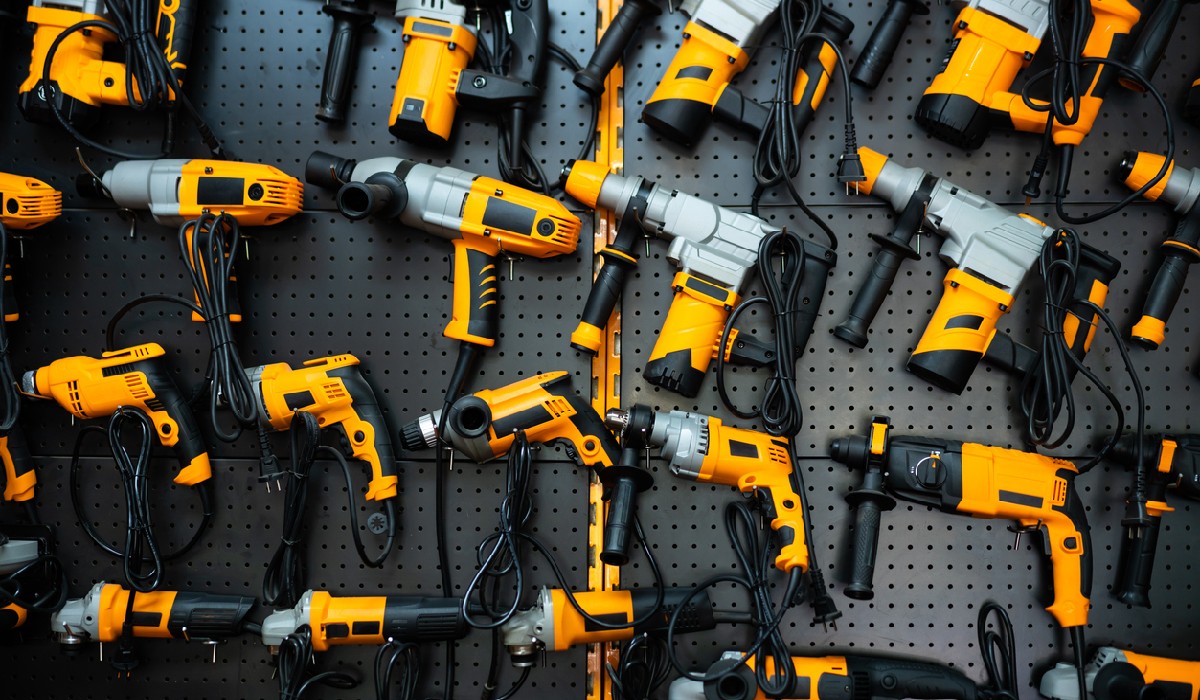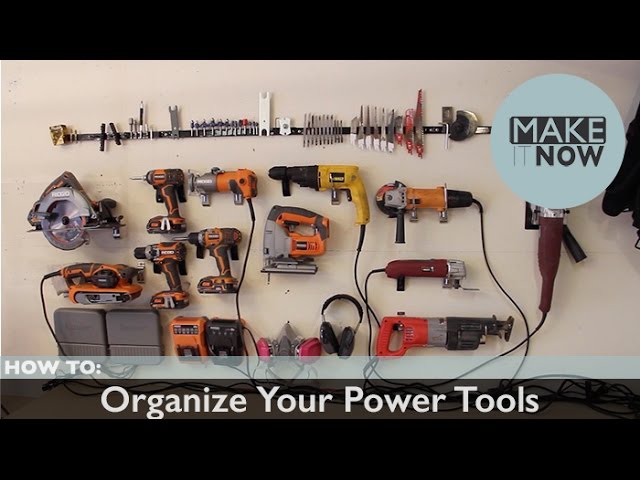Are your power tools scattered around your workspace, making it hard to find the right one when you need it? You’re not alone.
Many people struggle with keeping their tools organized, leading to frustration and wasted time. Imagine the satisfaction of having every tool in its place, easily accessible and ready for your next project. By learning how to organize your power tools effectively, you can transform your workspace into a haven of efficiency and creativity.
This article will guide you through simple steps to help you regain control over your tools and maximize productivity. Let’s dive in and discover how a well-organized tool setup can not only save you time but also inspire your next big project.
:max_bytes(150000):strip_icc()/75567006_731773897327460_1139893686297985030_n-ba90fc26adf144a69886aa6f2dbfe6be.jpg)
Credit: www.thespruce.com
Choosing The Right Storage Solutions
Choosing the right storage solutions for your power tools is crucial for maintaining an organized workspace. A well-organized tool area not only saves time but also enhances safety by preventing clutter. Let’s dive into some effective storage solutions that can help you keep your tools tidy and easily accessible.
Wall Mounts And Pegboards
Wall mounts and pegboards are excellent for displaying your tools while keeping them within reach. They make it easy to locate the tool you need without rummaging through boxes or drawers. If you have limited floor space, these can be a game-changer.
One weekend, I installed a pegboard in my garage and hung all my frequently used tools. It was a straightforward project that transformed my workspace. Have you thought about how much time you could save with a similar setup?
Consider customizing the layout of your pegboard to suit your tool collection. Hooks, baskets, and shelves can be added to accommodate different sizes and types of tools. This adaptability is perfect for evolving toolsets.
Shelving Units And Cabinets
Shelving units and cabinets offer more enclosed storage solutions. They are ideal for keeping tools that are not used daily but still need to be accessible. These options help protect your tools from dust and potential damage.
Incorporating shelves into your storage system can help categorize tools by function or frequency of use. Cabinets with doors provide a clean look and can be locked for additional security. How secure do you feel about your current tool storage?
Adjustable shelves can maximize the available space, allowing you to store both large equipment and smaller items efficiently. This flexibility makes shelving units a versatile choice for any workshop.
Portable Tool Boxes And Bags
For those who frequently work on projects outside their main workspace, portable tool boxes and bags are indispensable. They provide mobility, allowing you to bring essential tools wherever you go. Think about the convenience of having all your necessary tools in one place, ready to transport.
Investing in a durable, well-organized tool bag can save you from the frustration of forgetting important tools at home. When was the last time you wished you had a specific tool with you on a job?
Look for tool boxes with customizable compartments to fit your unique collection. This ensures that each tool has its designated spot, preventing damage and making retrieval quick and easy.
By carefully selecting the storage solutions that match your needs, you can create a more efficient and enjoyable workspace. Have you identified which storage option fits your style best?
Categorizing Tools For Easy Access
Organizing your power tools doesn’t have to be a daunting task. Properly categorizing them can make your workspace more efficient and enjoyable. Imagine reaching for a tool and finding it immediately without rummaging through piles. Wouldn’t that be a relief? Let’s dive into some practical ways to categorize your power tools for easy access.
Grouping By Function
Think about the primary function of each tool. Grouping tools by function can streamline your workflow. Place all your cutting tools together, such as saws and cutters. Organize drilling tools like drills and impact drivers in one spot.
This method helps you quickly locate the tools you need for specific tasks. Picture having a dedicated shelf or drawer for all your measuring tools. You know exactly where to go when starting a project. It’s a simple change that saves time.
Sorting By Frequency Of Use
Consider how often you use each tool. Tools you use frequently should be easily accessible. Store them at eye level or in a front-facing position. This prevents unnecessary bending or reaching.
Have you ever wasted time searching for your favorite screwdriver because it was buried? Keep those high-use tools within arm’s reach. You’ll thank yourself every time you start a new project.
On the other hand, tools you rarely use can go in less accessible spots. This creates more space for the items you use daily. Why clutter your workbench with things you seldom need?
Organizing your power tools is not just about tidiness. It’s about creating a space that works for you. How would your workshop change if you could grab any tool without hesitation? Give these strategies a try and transform your workspace.
Labeling Systems For Quick Identification
Finding the right power tool can be a challenge without proper organization. Labeling systems can transform your workspace into a well-organized haven. Quick identification of tools saves time and reduces frustration. Let’s explore how labeling can enhance your efficiency.
Using Color-coded Labels
Color-coded labels simplify tool identification. Assign different colors to various tool categories. For instance, use red for drills and blue for saws. This visual method speeds up the finding process. It minimizes the chances of grabbing the wrong tool.
Colors are easy to recognize at a glance. They work well in busy workshops. Ensure each tool is labeled clearly. Use durable labels that withstand wear and tear. This ensures labels remain intact over time.
Implementing Digital Inventory Systems
Digital inventory systems modernize tool tracking. Apps offer detailed records of your tools. Input each tool’s location and condition. Access this information via your smartphone or tablet. Updates are easy and keep your inventory current.
Digital systems reduce the need for physical searching. They help locate tools quickly. Some apps offer barcode scanning features. Scan the tool’s code for instant information. This method integrates seamlessly with your labeling system.
Digital inventory systems offer backup for your physical labels. They enhance organization and ensure accurate tracking. Consider using a digital system alongside color-coded labels. Together, they provide comprehensive tool management.

Credit: www.woodsmith.com
Maintenance And Safety Practices
Power tools are essential for many DIY projects and professional tasks. Keeping them in good condition ensures they work efficiently. Proper maintenance and safety practices help extend their life. They also protect you from potential hazards. Learn about cleaning, inspection, and safe storage.
Regular Cleaning And Inspection
Regular cleaning prevents dust and debris buildup in power tools. Use a soft brush to remove dirt from crevices. Compressed air is effective for tight spots. Inspect tools for damage before and after use. Check for frayed cords and loose parts. A quick inspection can prevent accidents and prolong tool life.
Safe Storage Techniques
Store power tools in a dry, cool place. Moisture can cause rust and damage. Use pegboards or shelves for organized storage. Keep tools away from children and pets. Label storage areas for quick access. Secure tools in cases or boxes to prevent accidental falls.
Maximizing Workspace Efficiency
Organize power tools efficiently by grouping similar items together and labeling storage spaces. Use wall-mounted racks and pegboards to keep frequently used tools accessible. Regularly clean and declutter to maintain order and increase productivity.
Maximizing workspace efficiency is crucial for any DIY enthusiast. A well-organized tool area saves time and boosts productivity. Every tool should have a specific place. This reduces clutter and makes it easy to find what you need. An efficient setup enhances your work experience and keeps your projects running smoothly.
Optimizing Tool Placement
Tool placement is key to efficiency. Store frequently used tools within easy reach. Use pegboards or shelves to keep tools visible. Group similar tools together. This makes it simple to grab the right tool fast. Consider wall-mounted systems for heavy tools. This frees up floor space and keeps your area tidy.
Creating Dedicated Work Zones
Dedicated work zones streamline your tasks. Define areas for specific activities. Set up a zone for cutting, another for assembly. This minimizes movement and saves time. Use labels to identify each zone. Keep necessary tools in their respective zones. This ensures everything is where you need it. A clear layout boosts focus and reduces distractions.
Innovative Organization Hacks
Organizing power tools doesn’t have to be a daunting task. With some creativity, you can make the most of your space. Innovative organization hacks can transform clutter into order. These hacks use everyday items and custom solutions.
Repurposing Household Items
Look around your home for unused items. Old shoe racks can hold drills and saws. Use kitchen spice racks for small tool parts. Empty jars can organize screws and nails. Repurpose old bookshelves for larger tools. Hang tools from shower curtain hooks. This method saves money and space.
Diy Custom Storage Solutions
Create your own tool storage to fit your needs. Build a pegboard wall to hang tools. Use PVC pipes to store long-handled tools vertically. Make a rolling cart for easy tool transport. Design shelves with pallets for cost-effective storage. Personalize drawers for specific tools and accessories. This approach ensures everything has a place.

Credit: www.youtube.com
Frequently Asked Questions
How Do I Organize My Power Tools?
Use wall-mounted shelves and pegboards for tool visibility. Group similar tools for easy access. Label storage bins for quick identification. Keep frequently used tools within reach. Maintain a clean workspace by regularly decluttering.
How Should Power Tools Be Stored?
Store power tools in a dry, clean area to prevent rust. Use sturdy shelves or pegboards for organization. Keep tools unplugged and covers on sharp parts for safety. Ensure adequate ventilation to avoid moisture buildup. Regularly inspect tools for damage before storing.
How Should Tools Be Organized?
Organize tools by grouping similar items together, labeling shelves or containers, and ensuring easy access. Use pegboards, toolboxes, or cabinets for optimal storage. Regularly declutter and maintain order for efficient use. Store frequently used tools at eye level and heavier tools lower for safety.
How Do You Organize Electrician Tools?
Organize electrician tools by using a toolbox with compartments. Label each section for easy identification. Store frequently used tools in accessible spots. Use pegboards or wall-mounted racks for larger tools. Regularly clean and inventory tools to maintain order. Keep similar tools together for efficient workflow.
Conclusion
Organizing power tools keeps your workspace neat and efficient. Follow simple steps. Sort tools by type and size. Use shelves, racks, or boxes for storage. Label everything for easy access. Regularly clean and maintain your tools. This ensures they last longer.
Safety is important. Keep cords and sharp tools out of reach. Avoid clutter to prevent accidents. An organized space boosts productivity and saves time. Enjoy a tidy, functional workshop. Happy organizing!






